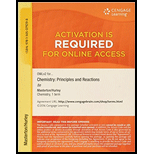
(a)
Interpretation:
The relation between the pH of beaker A and beaker B needs to be determined.
Concept introduction:
The molarity of a solution is defined as number of moles of solute present in 1 L of the volume of solution.
The pH of the solution depends on the molarity of hydrogen ion concentration. It is calculated as negative log of hydrogen ion concentration.
(b)
Interpretation:
The relation between pH of beaker A and C needs to be determined.
Concept introduction:
The molarity of a solution is defined as number of moles of solute present in 1 L of the volume of solution.
The pH of the solution depends on the molarity of hydrogen ion concentration. It is calculated as negative log of hydrogen ion concentration.
(c)
Interpretation:
The relation between the pH of beaker D and beaker E needs to be determined.
Concept introduction:
The molarity of a solution is defined as number of moles of solute present in 1 L of the volume of solution.
The pH of the solution depends on the molarity of hydrogen ion concentration. It is calculated as negative log of hydrogen ion concentration.
(d)
Interpretation:
The relation between the pH of beaker A and beaker E needs to be determined.
Concept introduction:
The molarity of a solution is defined as number of moles of solute present in 1 L of the volume of solution.
The pH of the solution depends on the molarity of hydrogen ion concentration. It is calculated as negative log of hydrogen ion concentration.
(e)
Interpretation:
The relation between the pH of beaker A and beaker D needs to be determined.
Concept introduction:
The molarity of a solution is defined as number of moles of solute present in 1 L of the volume of solution.
The pH of the solution depends on the molarity of hydrogen ion concentration. It is calculated as negative log of hydrogen ion concentration.
Want to see the full answer?
Check out a sample textbook solution
Chapter 14 Solutions
CHEMISTRY:PRIN.+REACTIONS-OWLV2 ACCESS
- Assign the functional group bands on the IR spectra.arrow_forwardFind the pH of a 0.120 M solution of HNO2. Find the pH ignoring activity effects (i.e., the normal way). Find the pH in a solution of 0.050 M NaCl, including activityarrow_forwardPlease help me answer these three questions. Required info should be in data table.arrow_forward
- Draw the major organic substitution product or products for (2R,3S)-2-bromo-3-methylpentane reacting with the given nucleophile. Clearly drawn the stereochemistry, including a wedged bond, a dashed bond and two in-plane bonds at each stereogenic center. Omit any byproducts. Bri CH3CH2O- (conc.) Draw the major organic product or products.arrow_forwardTartaric acid (C4H6O6) is a diprotic weak acid. A sample of 875 mg tartaric acid are dissolved in 100 mL water and titrated with 0.994 M NaOH. How many mL of NaOH are needed to reach the first equivalence point? How many mL of NaOH are needed to reach the second equivalence point?arrow_forwardIncluding activity, calculate the solubility of Pb(IO3)2 in a matrix of 0.020 M Mg(NO3)2.arrow_forward
- Order the following series of compounds from highest to lowest reactivity to electrophilic aromatic substitution, explaining your answer: 2-nitrophenol, p-Toluidine, N-(4-methylphenyl)acetamide, 4-methylbenzonitrile, 4-(trifluoromethyl)benzonitrile.arrow_forwardOrdene la siguiente serie de compuestos de mayor a menor reactividad a la sustitución aromática electrofílica, explicando su respuesta: ácido bencenosulfónico, fluorobenceno, etilbenceno, clorobenceno, terc-butilbenceno, acetofenona.arrow_forwardCan I please get all final concentrations please!arrow_forward
 Chemistry: Principles and ReactionsChemistryISBN:9781305079373Author:William L. Masterton, Cecile N. HurleyPublisher:Cengage Learning
Chemistry: Principles and ReactionsChemistryISBN:9781305079373Author:William L. Masterton, Cecile N. HurleyPublisher:Cengage Learning General, Organic, and Biological ChemistryChemistryISBN:9781285853918Author:H. Stephen StokerPublisher:Cengage Learning
General, Organic, and Biological ChemistryChemistryISBN:9781285853918Author:H. Stephen StokerPublisher:Cengage Learning ChemistryChemistryISBN:9781305957404Author:Steven S. Zumdahl, Susan A. Zumdahl, Donald J. DeCostePublisher:Cengage Learning
ChemistryChemistryISBN:9781305957404Author:Steven S. Zumdahl, Susan A. Zumdahl, Donald J. DeCostePublisher:Cengage Learning Chemistry: An Atoms First ApproachChemistryISBN:9781305079243Author:Steven S. Zumdahl, Susan A. ZumdahlPublisher:Cengage Learning
Chemistry: An Atoms First ApproachChemistryISBN:9781305079243Author:Steven S. Zumdahl, Susan A. ZumdahlPublisher:Cengage Learning
 Introduction to General, Organic and BiochemistryChemistryISBN:9781285869759Author:Frederick A. Bettelheim, William H. Brown, Mary K. Campbell, Shawn O. Farrell, Omar TorresPublisher:Cengage Learning
Introduction to General, Organic and BiochemistryChemistryISBN:9781285869759Author:Frederick A. Bettelheim, William H. Brown, Mary K. Campbell, Shawn O. Farrell, Omar TorresPublisher:Cengage Learning





